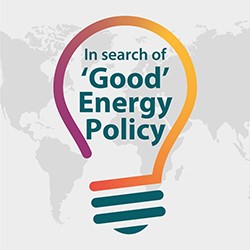The energy transition patterns of low-income households in South Africa: An evaluation of energy programme and policy
DOI:
https://doi.org/10.17159/2413-3051/2018/v29i3a3310Keywords:
Keywords, energy ladder, energy stacking, low-income, energy policy, energy programmeAbstract
The transition to modern energy carriers like electricity is an important way to achieve to eradicate energy poverty. This study investigated energy transition patterns and trends in low-income South African households. The marginal effects of the different determinants on the probability of choosing a specific energy carrier were computed and the influence of some endogenous characteristics in transitioning to modern energy carriers was explored. It was found that energy ladder behaviour exists for cooking while energy stacking was most likely for space heating and the pattern for lighting tended towards energy stacking. Dwelling type, household size and geographical location were among the key determinants of the energy transition pattern. Policies to reduce energy poverty need a multi-pronged approach and not only a focus on electricity access.
Downloads
References
Agresti, A. 2010. Analysis of ordinal categorical data, Second edition. New York: Wiley.
https://doi.org/10.1002/9780470594001
Arnold, J.E.M., Kohlin, G. and Persson, R. 2006. Wood fuels, livelihoods and policy interventions: Changing perspectives. World Development, 34 (3): 596–611.
https://doi.org/10.1016/j.worlddev.2005.08.008
Baiyegunhi, L.J.S. and Hassan, M.B. 2014. Rural household fuel and energy transition: Evidence from Giwa LGA Kaduna State, Nigeria. Energy for Sus-tainable Development, 20: 30-35.
Brown, M., Daniels, R., De Villiers, L., Leibbrandt, M. and Woolard, I. 2012. National Income Dynamics Study Wave 2 User Manual. Southern Africa Labour and Development Research Unit, University of Cape Town, Cape Town, South Africa.
Buis, M. 2010. Interpretation of interactions in non-linear models. The Stata Journal, 10: 305-308.
Davis, M. 1998. Rural household energy consumption: The effects of access to electricity- Evidence from South Africa. Energy Policy, 26(3): 207–217.
https://doi.org/10.1016/S0301-4215(97)00100-6
Department of Energy (DoE). 2013. Integrated Resource Plan for Electricity (IRP) 2010-2030. Update report 2013. Pretoria: South Africa.
Department of Minerals and Energy (DME). 2003. Elec-tricity basic services support tariff (free basic electricity policy). Pretoria. Available at: www.energy.gov.za
Greene, W.H. 2008. Econometric analysis. Sixth Edition. Upper Saddle River, New Jersey: Prentice Hall.
Gujarati, D.N. and Porter, D.C. 2009. Basic economet-rics. Fifth Edition. Mc Graw-Hill, New York.
Hosier, R.H. and Dowd, J. 1987. Household fuel choice in Zimbabwe: An empirical test of the energy ladder hypothesis. Journal of Resources and Energy, 9: 347-361.
https://doi.org/10.1016/0165-0572(87)90003-X
Howells, M.I., Alfstad, T., Victor, D.G., Goldstein, G. and Remme, U. 2003. An energy model for a low in-come rural African village. Energy Research Centre, University of Cape Town, Cape Town, South Africa. Working Paper Number 18.
Hsiao, C. 2014. Analysis of panel data, Volume 54. Cambridge University Press.
https://doi.org/10.1017/CBO9781139839327
Inglesi-Lotz, R. 2010. Electricity demand in South Africa: Conditional forecasts to 2030. Applied Energy, 87: 197-204.
https://doi.org/10.1016/j.apenergy.2009.08.017
International Energy Agency (IEA). 2002. Energy pov-erty. World Energy Outlook. Paris.
Joyeux, R. and Ripple, R.D. 2007. Household energy consumption versus income and relative standard of living: A panel approach. Energy Policy, 35 (1): 50–60.
https://doi.org/10.1016/j.enpol.2005.10.012
Kowsari, R. and Zerriffi, H. 2011. Three dimensional energy profiles: A conceptual framework for as-sessing household energy use. Journal of Energy Policy, 39: 7505–7517.
https://doi.org/10.1016/j.enpol.2011.06.030
Lay, J., Ondraczek, J. and Stoever, J. 2013. Renewables in the energy transition: Evidence on solar home sys-tems and lighting fuel choice in Kenya. Energy Eco-nomics, 40: 350–359.
https://doi.org/10.1016/j.eneco.2013.07.024
Lee, S.M., Kim, Y., Jaung, W. Latifah, S., Afifi, M. and Fisher, L.A. 2015. Forests, fuelwood and livelihoods – Energy transition patterns in Eastern Indonesia. Energy Policy, 85: 61-70.
https://doi.org/10.1016/j.enpol.2015.04.030
Leibbrandt, M., Woolard, I. and de Villiers, L. 2009. Methodology: Report on NIDS Wave 1. Southern Af-rica Labour and Development Research Unit (SALDRU), University of Cape Town, Cape Town, South Africa. Technical paper, volume 1.
Liu, W., Spaargaren, G., Heerick, N., Mol, A.P.J. and Wang, C. 2013. Energy consumption practices of ru-ral households in North China: Basic characteristics and potential for low carbon development. Energy Policy, 55: 128-138.
https://doi.org/10.1016/j.enpol.2012.11.031
Long, J.S. and Freese, J. 2014. Regression models for categorical dependent variables using Stata. Third Edition. College Station, Texas, USA: Stata.
Madubansi, M. and Shackleton, C.M. 2006. Changing energy profiles and consumption patterns following electrification in five rural villages, South Africa. En-ergy Policy, 34(18): 4081-4092.
https://doi.org/10.1016/j.enpol.2005.10.011
Martins, J. 2005. The impact of the use of energy sources on the quality of life of poor communities. Social Indicators Research, 72: 373–402.
https://doi.org/10.1007/s11205-004-5583-z
National Income Dynamics Study (NIDS) 2012. Wave 1: Introduction to NIDS data, Cape Town: Southern Af-rica Labour and Development Research Unit (SALDRU), University of Cape Town, Cape Town, South Africa.
Nissing, C. and von Blottnitz, H. 2010. Renewable ener-gy for sustainable urban development: Redefining the concept of energisation. Energy Policy, 38: 2179-2187.
https://doi.org/10.1016/j.enpol.2009.12.004
O'Connell, A. A. 2005. Logistic regression models for ordinal response variables. Thousand Oaks, Califor-nia, USA: Sage.
Ruiters, G. 2009. Free Basic Electricity in South Africa: A strategy for helping or containing the Poor? In: McDonald, D.A. (Ed.), Electric capitalism: Recolonis-ing Africa on the power grid. Cape Town: HSRC.
Suliman, K.M. 2013. Factors affecting the choice of households' cooking fuel in Sudan. Working paper.
Swart, D. and Bredenkamp, B. 2012. The challenge of addressing household energy poverty. Conference paper presented at 'Towards Carnegie' in University of Cape Town, Cape Town, South Africa. September 3-7.
Uhunamure, S.E., Nethengwe, N.S. and Musyoki, A. 2017. Driving forces for fuelwood use in households in the Thulamela municipality, South Africa. Journal of Energy in Southern Africa, 28(1): 25-34.
https://doi.org/10.17159/2413-3051/2017/v28i1a1635
Van der Kroon, B., Brouwer, R. and van Bekeuring, P.J.H. 2013. The energy ladder: Theoretical myth or empirical truth? Results from a meta-analysis. Re-newable and Sustainable Energy Reviews, 20: 504–513.

Downloads
Additional Files
Published
Issue
Section
License
Copyright (c) 2018 Sylvia Olawumi Israel-Akinbo, Jen Snowball, Gavin Fraser

This work is licensed under a Creative Commons Attribution-ShareAlike 4.0 International License.



.png)